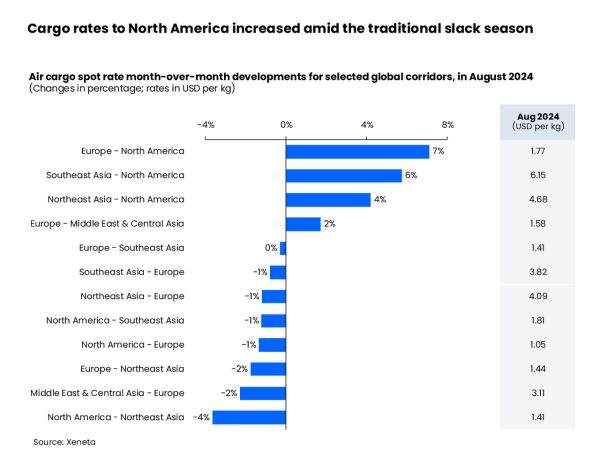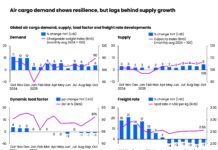The global air cargo market’s hot summer continued in August with average spot rates showing their largest year-on-year growth of +24%, according to the latest weekly analysis by Xeneta.
Global average air cargo spot rates of US$ 2.68 per kg in August were boosted by continuing supply and demand imbalance. August’s global cargo supply grew at its slowest ratio in 2024 to-date at 2% year-on-year, while global cargo demand continued its double-digit growth, rising +11%. The increase was further supported by ocean-to-air shift due to Red Sea disruptions and e-commerce demand.
E-commerce continued to show strong growth as the market continued to cruise towards its hotly anticipated peak season. According to Trade and Transport Group, e-commerce and low-value goods exports from China in the first seven months of 2024 increased +30% year-on-year. Notably, shipments to Europe and the US showed +38% and +30% growth respectively.
“Typically, air cargo market performance in August tends to follow the July trend. But another month of double-digit demand growth and the strongest rate growths of the year means there was definitely no summer slack season in 2024,” said Xeneta chief airfreight officer, Niall van de Wouw. “Rates we saw bottoming out in late July started picking up again in mid-August. This is too short a period to call a season. This has been a busy summer, and now we’re at the threshold of Q4, it will be interesting to see what will happen and if all the anticipation of a red hot peak season materialises.”
It is worth noting that the growth momentum of global air cargo volumes did slow in August compared to earlier this year. This, however, was anticipated, with the following months likely to follow suit. This is in part because demand in the corresponding months earlier in 2023 was weaker compared to the peak in volumes in Q4 2023.
In terms of dynamic load factor – Xeneta’s measurement of capacity utilisation based on volume and weight of cargo flown alongside available capacity – the supply/demand imbalance led to the global load factor increasing +4 percentage points year-on-year to 58% in August.
Rate update
Looking at month-on-month developments, the global air cargo market saw spot rates soften (-1% month-on-month) in August, likely reflecting a slight cooling of ocean-to-air shift due to ocean shipping frontloading of imports.
Zooming into the corridor level, inbound North America air cargo rates, among selected global corridors, registered the largest increases from a month ago during what is usually considered to be the industry’s traditional slack season.
Topping the list, Europe to North America air spot rates rose +7% from a month ago to $1.77 per kg in August. In addition to a low comparison base, the increase in Transatlantic rates could be a result of the surging transhipments originating from Asia. This is followed by Southeast and Northeast Asia to North America rates, which increased +6% and +4% to $6.15 per kg and 4.68 per kg respectively.
Europe to the Middle East and Central Asia rates, the last corridor in Xeneta’s selected list to show growth, ticked up +2% from a month ago to $1.58 per kg.
For the inbound Europe air cargo market from Asia and the Middle East, summer breaks and respite from Red Sea disruptions led to softened air cargo rates, down -1-2% month-on-month.
Lastly, inbound Northeast and Southeast Asia spot rates from North America and Europe experienced the largest decreases up to -4% from a month ago. This is mainly due to the increased trade imbalance between fronthaul and backhaul trades.
Dynamic load factor from Asia Pacific to both Europe and North America stood at 86% and 87% respectively in August. In contrast, their return legs were below 45% in the same period.
Nervousness over peak season
According to van de Wouw, September will be a ‘good indicator’ of what Q4 will bring. Let’s see if the peak surcharges some carriers plan to implement will hold,” he said. “Freight forwarders are more prepared this year and, based on what we hear, are spending a lot of time with shippers on how to manage the unpredictable nature of these market conditions. We see financial and operational de-risking going on but, if the heat is on, let’s see what happens with all the contracts that are being negotiated.
“We’ve seen rates increasing throughout the summer, which is not typically the case. Q4 will be busy in terms of volumes, but how busy? E-commerce demand will play a big role and with +30% growth already this year ex-China and a reported 37 million new downloads of just the TEMU app in July, the indicators already suggest strong demand for capacity and this will impact the entire market on major corridors.
“I said to a shipper last week if you are not already a little bit nervous, I would recommend you get a little bit nervous for Q4 when you look at all the signals out there.”
Van de Wouw added: “Especially out of Asia, we should not be surprised if the market really heats up again in Q4. We expect to see a seller’s market out of Asia and across the Atlantic due to the latter’s reduction in winter capacity. We’ve had a hot summer, and we may have an even hotter autumn ahead.”











